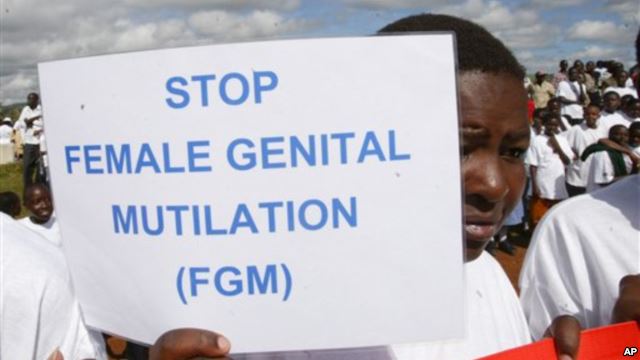UN Launches Global Campaign to End Female Genital Mutilation
UNITED NATIONS, 3 Nov 2014
Voice of America – TRANSCEND Media Service
30 Oct 2014 – The U.N. secretary-general has launched a global media campaign aimed at putting an end to female genital mutilation.
In 2012, the U.N. General Assembly adopted a resolution declaring zero tolerance for female genital mutilation [FGM], hoping to raise awareness against the practice.
A U.N. report estimates 125 million girls and women have been cut in 29 countries in Africa and the Middle East. It says If current trends continue, 86 million young girls are likely to undergo some form of the practice by 2030.
In Kenya’s capital, Nairobi, U.N. Secretary-General Ban Ki-moon launched a pioneering global media campaign Thursday that seeks to radically change how female genital mutilation is reported and perceived across the world.
Ban Ki Moon stressed the need for a concerted effort for this form of gender violence to end.
“The mutilation of girls and women must stop in this generation and our generation. Men and boys must also be encouraged to support the fight against FGM and they should be praised when they do,” said Ban. “The good news is that entire communities in Kenya and elsewhere Africa and around the world have decided to end FGM.“
FGM is mostly carried out on young girls sometime between infancy and age 15. It can cause severe bleeding and health issues including cysts, infections and infertility, as well as complications in childbirth and increased risk of newborn deaths.
According to Ban, the U.N. has noted the practice is a violation of human rights.
“Ending FGM is part of the U.N.’s unwavering campaign for the health, human rights for the empowerment of women and girls. We salute the girls and women who have fought against FGM and reclaimed their bodies,” said Ban, who added that the practice must be stopped.
In Kenya the government has outlawed female genital mutilation. But in remote parts of the country FGM is still practiced under secrecy.
Dr. Kakenya Ntaiya began the non-profit Kakenya Center for Excellence in 2009 in Enoosaen, Kenya. One of its goals is to rescue girls from early forced marriages and FGM. The school currently has 170 students in grades four through eight. At the launch of the media campaign, Ntaiya shared her personal experience with FGM.
“In the 90’s when the practice was done to me and others it was done publicly. It was celebrated, everybody attended, it was done outside in the morning with everybody seeing,” said Ntaiya. “We did not know then that it was against the law or it was something that is actually harmful to women, we just did it because we were told this is something that makes you a real woman.”
Kenya’s government notes that the prevalence of FGM has dropped markedly thanks to a concerted effort. In 2001, Kenya passed a law to criminalize FGM, especially for girls under 18. It went into effect in 2011.
At Thursday’s event, Kenya’s Cabinet Secretary for Devolution & Planning Ann Waiguru highlighted government efforts thus far.
“The government has established the anti-FGM board and developed a policy to implement the prohibition of FGM according to the FGM Act 2011. The government has also employed various strategies in the campaign against FGM, these include awareness raising and education campaigns and the promotion of alternative rights of passage. Further the government has deployed prosecutors to ensure the perpetrators are brought to book,” she said.
Earlier this year, President Barack Obama and British Prime Minister David Cameron spoke out against FGM with the aim of stopping it worldwide.
DISCLAIMER: The statements, views and opinions expressed in pieces republished here are solely those of the authors and do not necessarily represent those of TMS. In accordance with title 17 U.S.C. section 107, this material is distributed without profit to those who have expressed a prior interest in receiving the included information for research and educational purposes. TMS has no affiliation whatsoever with the originator of this article nor is TMS endorsed or sponsored by the originator. “GO TO ORIGINAL” links are provided as a convenience to our readers and allow for verification of authenticity. However, as originating pages are often updated by their originating host sites, the versions posted may not match the versions our readers view when clicking the “GO TO ORIGINAL” links. This site contains copyrighted material the use of which has not always been specifically authorized by the copyright owner. We are making such material available in our efforts to advance understanding of environmental, political, human rights, economic, democracy, scientific, and social justice issues, etc. We believe this constitutes a ‘fair use’ of any such copyrighted material as provided for in section 107 of the US Copyright Law. In accordance with Title 17 U.S.C. Section 107, the material on this site is distributed without profit to those who have expressed a prior interest in receiving the included information for research and educational purposes. For more information go to: http://www.law.cornell.edu/uscode/17/107.shtml. If you wish to use copyrighted material from this site for purposes of your own that go beyond ‘fair use’, you must obtain permission from the copyright owner.
